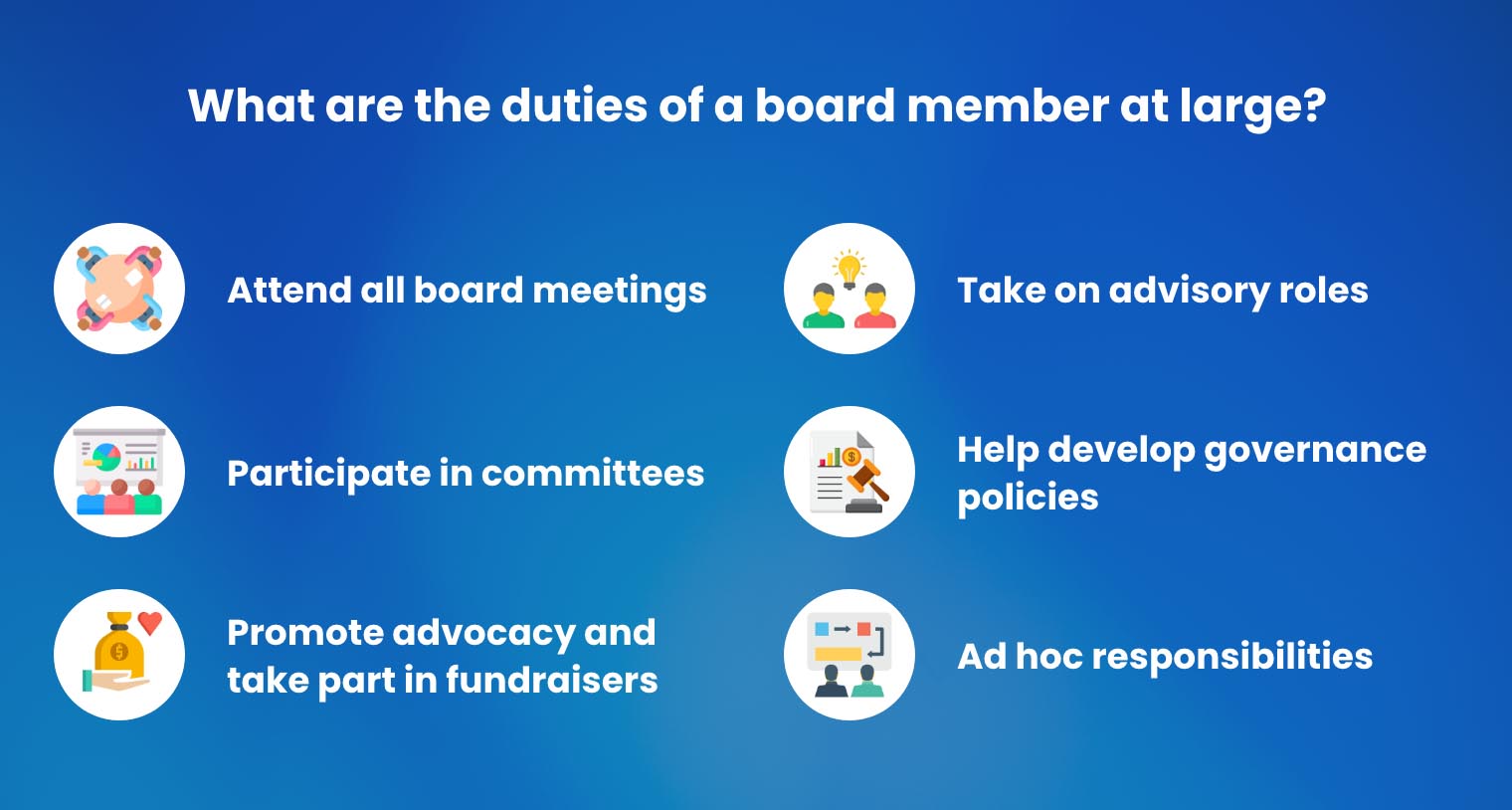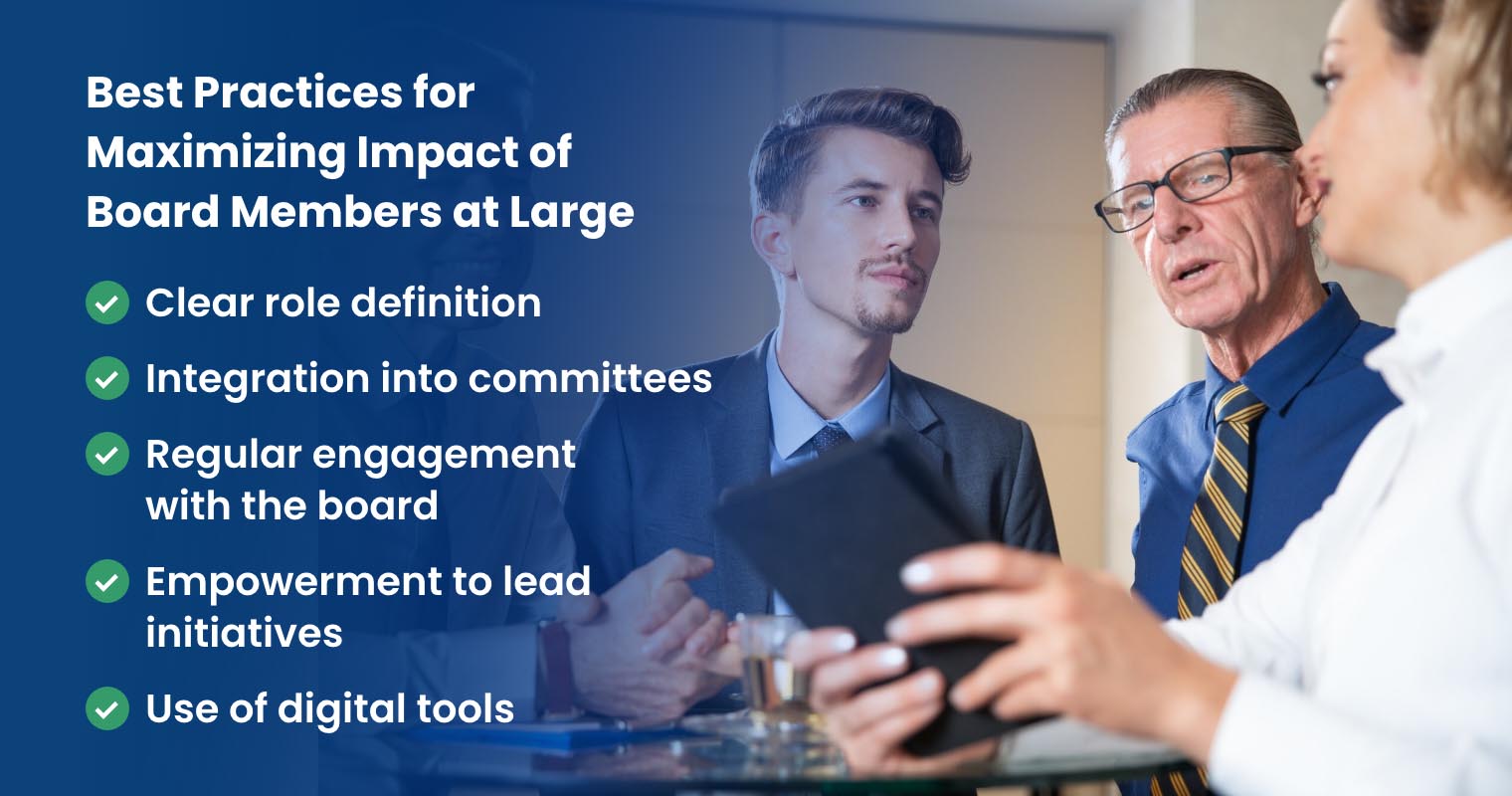Every board of directors member has a specific duty that they must fulfill to contribute to the organization’s success. For example, the chairperson leads meetings and ensures strategic alignment, while the executive secretary manages minutes and board logistics. While not assigned to a committee or a portfolio, a board member at large supports various initiatives and is just as important as the other members in ensuring a well-rounded governance.
Discover in this article what members at large mean, what they do, and who qualifies for the role. In the following sections, we’ll answer these questions and give you insights into best practices that maximize the impact of your board members at large.
What Does Member at Large Mean?
In a nutshell, a member at large refers to a board member who doesn’t have a specific board role or title. They are somewhat flexible contributors who fill in gaps to ensure that the board remains effective and responsive to the company’s evolving demands. A board member at large can join committees and even serve as the committee chair. They can be compared to a utility player in sports who doesn’t have a fixed position but contributes to the team wherever and whenever needed.
What does at large mean on a board?
‘At large’ on a board means the position has no definite assignment. Instead, they represent the entire organization and are not tied to a particular area or group within the board.
Why are members at large important?
Members at large maintain a balanced view of board matters. They attend board meetings like any other board member, provide input, and have the right to vote on key decisions. Although their role may seem less defined, their independence allows them to see things from a broader perspective, which prepares and shields the organization from risks they cannot foresee from a narrower viewpoint.
Board Member at Large vs. Ex Officio Board Members
Some may confuse members at large with ex officio members, but these roles are quite different. Members at large, as mentioned above, are general board members who can be deployed flexibly. In contrast, ex officio members hold board positions due to their official organizational roles.
Moreover, members at large are typically elected or appointed, while ex officio members automatically become board members by virtue of their existing positions. Members at large function as typical board members, participating in voting and offering valuable insights. On the other hand, the voting rights of ex officio members may vary depending on the bylaws of a specific organization.
What are the duties of a board member at large?

The roles and responsibilities of a member at large vary depending on the board’s requirements and structure. What does a member at large do? Here are their typical duties:
- Attend all board meetings: Board meetings are where important discussions take place. For the members at large to gain an understanding of the board’s direction, they must be present and participate in all full board meetings. This also allows them to weigh in on issues, vote according to their principles, and contribute to the decision-making process.
- Take on advisory roles: In most organizations, members at large are specialists who serve in an advisory capacity. They help with special projects or provide an external viewpoint on complex issues. Their input is highly valuable, as they often have a bird’s-eye view of the organization’s overall direction and strategy.
- Participate in committees: Members at large frequently and actively participate in one committee after another wherever their expertise is needed. For instance, they can utilize their skills by helping the audit committee ensure the accuracy and reliability of the organization’s financial reporting. Then, they will bring the committee reports back to the executive board for oversight.
- Help develop governance policies: Board members at large may take part in the development of governance protocols, bylaws, and strategies. This role requires them to draft, review, and oversee the process until it’s distributed to the full board for approval.
- Promote advocacy and take part in fundraisers: Members at large in a nonprofit setup engage and implement advocacy efforts that promote the organization’s mission. This often includes meeting with donors, speaking at public events, or representing the board in community or industry discussions to build relationships and improve the organization’s reputation. They also actively participate in fundraising events, lend their names to fundraising campaigns, or solicit donations from their networks.
- Ad hoc responsibilities: Ad hoc duties are additional tasks given to them by the chairperson or anyone within the board that maximize their strengths and allow their flexibility to tackle emerging issues, such as ESG initiatives, cybersecurity threats, and digital transformation strategies, which may not be assigned to other board roles.
How do members become members at large?
A lot of things are expected from members at large. Because they are supposed to cover a broad range of responsibilities and contribute to various board activities, they must be proactive, well-informed, and capable of working collaboratively with other board members. In terms of technicalities, here are the qualifications:
- Relevant coursework or specializations: Candidates typically need a bachelor’s or master’s degree in a related field, such as business or engineering. Others may even require a doctorate.
- Experience in governance: A proven track record of working on a board with demonstrated and documented fiduciary responsibility is necessary. Familiarity with the inner workings of board processes and governance structure is helpful when navigating discussions and contributing to business planning. Many members at large have prior experience in executive or advisory roles.
- Broad knowledge base: Since members at large serve without a specific focus, a diverse background in areas such as finance, law, human resources, or technology can be beneficial.
- Interpersonal skills: Given that their role often involves bridging gaps between different board members or committees, strong communication and negotiation skills are also crucial for the position.
- Strategic thinking: A member at large must understand the big picture and how their contributions fit into the organization’s broader goals.
What is the selection process?
Choosing members at large typically mirrors that of other board roles, although, due to its generalist nature, additional criteria may be used in some instances. Here is a quick seven-step selection process:
- Create guidelines and bylaws for the election process.
- Form a Nominating Committee at least six months before the election.
- Collect nominations from members of the Chair of each section through the Nominating Committee.
- Review the current board and determine how many positions are open.
- Propose and announce the list of candidates at least four weeks before the election.
- Provide members with details about each candidate and voting instructions. Members must submit their votes by the deadline.
- Announce the election results.
Once selected, the member at large is appointed through the standard onboarding process, where they are briefed on ongoing projects, governance processes, and specific challenges facing the organization.
Examples of Members at Large in Different Sectors
What does member at large mean for different sectors? As explained in the previous sections, they serve wherever they are needed. However, depending on the sector they represent, their capacities vary:
- Nonprofit: In nonprofit organizations, members at large often focus on community engagement, fundraising, and advocacy, leveraging their extensive networks to promote the organization’s mission and secure resources.
- Corporate: Corporate board members at large may provide oversight and contribute strategic perspectives from outside the company.
- Healthcare: In healthcare organizations, members at large are often assigned to furthering patient advocacies, quality improvement initiatives, and compliance with regulatory standards. Their guidance is needed to ensure that the board’s decisions reflect the needs of both patients and providers.
- University: Last but not least, members at large in academic institutions might be assigned special projects or appointed to ad hoc committees that address specific needs. For example, chosen members may serve on committees focused on diversity and inclusion initiatives or campus sustainability efforts.
Best Practices for Maximizing Impact of Board Members at Large
What makes an effective board member at large? Apart from the comprehensive screening process, there must be clarity and transparency about what is expected of them. If you are planning to hire a member at large or just need tips to boost the efficacy of your existing members, consider the following best practices:

Clear role definition
While the role is flexible, it’s essential to clarify the responsibilities and expectations from the outset. What does a member at large do in your organization? What committees might need an additional set of hands in the future? Does the position encompass the chairperson’s role? Having a set framework allows the members at large to focus on the areas where they can add the most value.
Integration into committees
We have established that board members at large should be a jack of all trades. But, it does not hurt to know where they excel the most. After learning about it, you can assign members at large to critical committees where their broad perspectives can help drive important decisions. For example, they may be a valuable addition to governance or audit committees.
Regular engagement with the board
Members at large are part of the board and should be included in all board discussions. This allows them to contribute to all areas of governance, and their voice should be heard in both strategic and operational conversations.
Empowerment to lead initiatives
Most members at large are leaders or have taken on leadership roles in the past. You must take advantage of their flexibility by having them lead cross-functional projects or special initiatives. These could include digital governance improvements, regulatory compliance, or stakeholder engagement.
Use of digital tools
Technology is changing the way boards function. To ensure that members at large are keeping up with the changes, they must have access to the necessary digital tools that streamline their work, such as board portals. According to Doodle, virtual meetings grew from 48% to 77% between 2020 and 2022, and so the need for a reliable meeting tool increased significantly. Platforms like Convene’s board portal help your board stay connected and organized and ensure governance transparency.
Elevate Board Governance with Convene

Board members at large make the board’s jobs easier by bridging the gaps. In most ways, Convene does that, too. The leading board management software helps centralize all board-related activities, from document management to review and approvals, simplifying board governance for everyone.
With features that enhance real-time collaboration, including live video conferencing and annotation tools that work during and after meetings, Convene enables seamless communication. Secure data sharing is also ensured through role-based access controls and document copy restrictions, while integrated digital signatures streamline the approval process. Additionally, Convene’s voting tools and action item tracking help members stay on top of their responsibilities and contribute more efficiently to the board.
Click here to learn more about Convene’s powerful features. For a more personalized experience, you can also schedule a one-on-one meeting with one of our product experts. Book a demo today!
Jess is a Content Marketing Writer at Convene who commits herself to creating relevant, easy-to-digest, and SEO-friendly content. Before writing articles on governance and board management, she worked as a creative copywriter for a paint company, where she developed a keen eye for detail and a passion for making complex information accessible and enjoyable for readers. In her free time, she’s absorbed in the most random things. Her recent obsession is watching gardening videos for hours and dreaming of someday having her own kitchen garden.


![How to Create a Board Skill Matrix + Template [Free Download]](https://cdn.azeusconvene.com/wp-content/uploads/2024Q3_Jul_Board-of-Directors-Skills-Matrix-Whitepaper-C-Dark.png)








